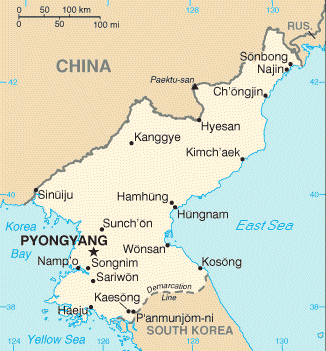|
Korea, North
|

|
Capital: Pyongyang
Population: 25,666,161
Brief History of Korea, North:
During the 1st century AD, Korea was divided into three kingdoms. They were the Shilla, the Koguryo, and the Pekche. The area remained this way until 668 AD when Korea was unified under the rule of the Shilla Kingdom. The Shilla kingdom was followed by the Koryo kingdom in 935 and then by the Choson dynasty in 1392. The name Korea comes from the Koryo kingdom.
Korea was invaded and conquered by other larger empires and countries throughout its history. The Mongol Empire ruled over Korea from 1231 until the 14th century and Japan invaded in the 1500s. In the 1900s both the Chinese and the Russians tried to invade Korea. In both cases the Japanese fought them off and took Korea as part of the Japanese Empire.
When Japan lost World War II, Korea was divided into two zones. The Soviet Union took control of the north and the United States the south. They were divided at the 38th parallel. This was meant to be a temporary division, but it is still there today. North Korea is the country that is north of the 38th parallel.
North Korea became an independent country in 1948. It was supported and dominated by the communist Soviet Union. In 1950 North Korea went to war against South Korea. The Korean War was the first major conflict of the Cold War.
Today North Korea is a communist country and keeps itself isolated from the rest of the world. Tensions between North and South Korea can be high.
The Geography of Korea, North
Total Size: 120,540 square km
Size Comparison: slightly smaller than Mississippi
Geographical Coordinates: 40 00 N, 127 00 E
World Region or Continent: Asia
General Terrain: mostly hills and mountains separated by deep, narrow valleys; coastal plains wide in west, discontinuous in east
Geographical Low Point: East Sea 0 m
Geographical High Point: Paektu-san 2,744 m
Climate: temperate with rainfall concentrated in summer
Major cities:
The People of Korea, North
Type of Government: Communist state one-man dictatorship
Languages Spoken: Korean
Independence: 15 August 1945 (from Japan)
National Holiday: Founding of the Democratic People's Republic of Korea (DPRK), 9 September (1948)
Nationality: Korean(s)
Religions: traditionally Buddhist and Confucianist, some Christian and syncretic Chondogyo (Religion of the Heavenly Way)
National Symbol: red star
National Anthem or Song: Aegukka (Patriotic Song)
Economy of Korea, North
Major Industries: military products; machine building, electric power, chemicals; mining (coal, iron ore, magnesite, graphite, copper, zinc, lead, and precious metals), metallurgy; textiles, food processing; tourism
Agricultural Products: rice, corn, potatoes, soybeans, pulses; cattle, pigs, pork, eggs
Natural Resources: coal, lead, tungsten, zinc, graphite, magnesite, iron ore, copper, gold, pyrites, salt, fluorspar, hydropower
Major Exports: minerals, metallurgical products, manufactures (including armaments), textiles, fishery products
Major Imports: petroleum, coking coal, machinery and equipment, textiles, grain
Currency: North Korean won (KPW)
National GDP: $40,000,000,000
** Source for population (2012 est.) and GDP (2011 est.) is CIA World Factbook.
Back to Geography Home Page
